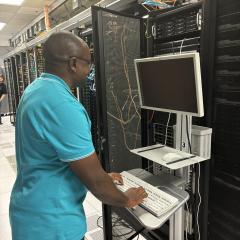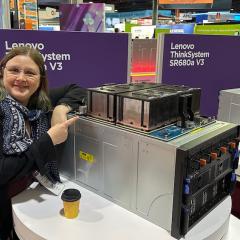
Data-intensive high performance computer FlashLite is enabling a UQ research team to work with NASA researchers and simulate new chemical materials for use in long manned space missions.
Prof. Debra J. Bernhardt and Dr Christoph Rohmann of UQ’s Australian Institute for Bioengineering and Nanotechnology are investigating composite materials using boron nitride nanotubes (BNNTs) for aerospace applications.
These new materials are expected to provide extreme strength and radiation shielding essential for lengthy space travel, and should result in novel designs of aircraft and spacecraft currently not possible with existing materials and structures technology.
To achieve this, Prof. Bernhardt and Dr Rohmann aim to identify metals — and at a later stage, also alloys — that would be suitable candidates for these composites.
They have already published one paper on their initial results in The Journal of Physical Chemistry C, and another paper co-authored with NASA researchers is in progress.
The UQ-side of the research is heavily reliant on FlashLite’s abilities to model large-scale systems, which are very memory-intensive.
“With the help of FlashLite we are trying to determine if the BNNTs and the metal can form a new strong and light composite, thus aiding the experimental studies conducted by NASA,” said Dr Rohmann.
“We found that the binding of aluminum is rather weak compared to titanium or copper. We’re working with NASA to test these predictions.
“FlashLite enabled us to model the charge distribution and binding energy for the BNNT-metal system, and to comment on the type and strength of the interaction. Flashlite was important since it provided the memory — in excess of 160 GB — required for such large systems.”
Prof. Bernhardt and Dr Rohmann also have access to computing infrastructure at NCI (they used NCI facilities for their calculations), based at ANU, and WA’s Pawsey Supercomputing Centre. However, they found FlashLite to be the best option for the large memory tasks.
“While one, in theory, could carry out the large memory calculations on clusters running many compute nodes parallel, the performance would decrease significantly with the number of nodes. This makes the calculations run longer and thus one would exceed the run-times provided by other computing infrastructures. In addition, requesting many compute nodes on a computing infrastructure causes the calculation to queue for a very long time, in some cases for weeks,” explained Dr Rohmann.
“FlashLite allowed us to run the desired memory-intensive calculations swiftly without having to go through the process of asking the respective computing support groups to make resources and time available to run these special systems.”
The future of the UQ research project, funded through the Asian Office of Aerospace Research and Development (AOARD), will see Prof. Bernhardt and Dr Rohmann modify their theoretical models based on NASA’s experimental findings. It will ultimately be important to develop methods that enable them to model the interaction of the BNNTs with metals and alloys at elevated temperatures.
Hopefully, one day, materials they have developed will be used in spacecraft for long manned missions. New, advanced materials are continually required to withstand extreme conditions such as those that would be encountered in the first human landing on Mars, which NASA aims to do in the 2030s.



